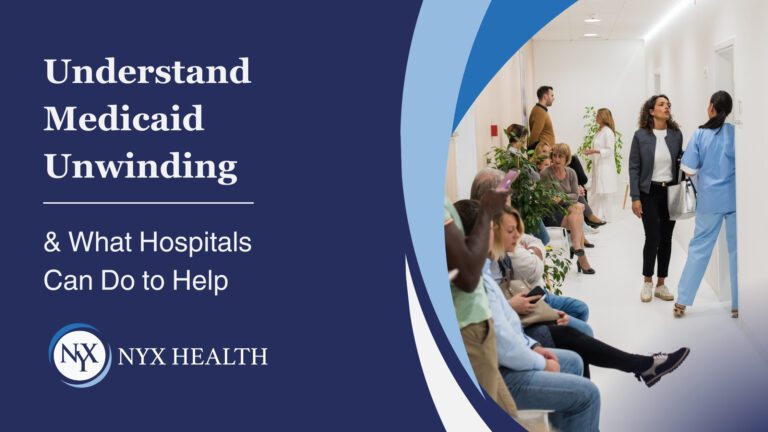Understand Medicaid Unwinding and What Hospitals Can Do to Help

Medicaid unwinding is an essential yet often misunderstood process with significant consequences for hospitals and their patients. As the public health emergency (PHE) declarations come to an end, states are resuming regular Medicaid operations, leading to the disenrollment of individuals who no longer meet eligibility criteria. This process, known as Medicaid unwinding, can create challenges for healthcare providers and patients. There are steps hospitals can take to assist their patient through this process, ensuring patients’ coverage continues.
What is Medicaid Unwinding?
Medicaid unwinding refers to the process states undertake to redetermine the eligibility of Medicaid enrollees following the end of the continuous enrollment condition. During the COVID-19 pandemic, continuous enrollment was mandated, preventing states from disenrolling individuals from Medicaid, regardless of changes in eligibility. With the PHE ending, states must review each enrollee's eligibility status, which can result in a significant number of individuals losing their coverage.
The Impact on Hospitals
-
Increased Uncompensated Care:
As individuals lose Medicaid coverage, hospitals are seeing a rise in uncompensated care, as these patients cannot afford insurance or out-of-pocket expenses.
-
Administrative Burden:
The process of verifying patient coverage and navigating the complexities of Medicaid policies increases the administrative workload for hospital staff.
-
Patient Health Outcomes:
Disenrollment can lead to interruptions in care, negatively affecting patient health outcomes and increasing emergency room visits.
Steps Hospitals Can Take to Help
Hospitals can play a pivotal role in supporting patients during this Medicaid unwinding process. Here are several strategies to consider:
-
Educate and Inform
- Patient Communication: Proactively communicate with patients about the unwinding process. Use various channels such as mail, email, text messages, and social media to ensure patients are aware of the potential changes to their coverage.
- Educational Materials - Provide clear and accessible information about how patients can verify their Medicaid eligibility, re-enroll if eligible, or explore alternative coverage options.
-
Assist with Enrollment
- On-Site Support - On-site enrollment assistance in hospitals and dedicated staff can help patients navigate the process. Partnering with organizations that specialize in Medicaid enrollment and other insurance can be beneficial and frees up your staff.
- Outreach Programs - Implement outreach programs to identify and assist patients who may be at risk of losing coverage. This can include phone calls, home visits, or community events.
-
Collaborate with Community Organizations
- Partnerships - Partner with local community organizations, health departments, and advocacy groups to provide comprehensive support to patients. These collaborations can help extend the reach of enrollment assistance and ensure patients receive the help they need.
- Resource Sharing - Share resources and best practices with other healthcare providers and community organizations to improve the overall effectiveness of enrollment efforts. Get the word out!
-
Leverage Technology
- Automated Reminders - Use automated systems to send reminders to patients about important dates and deadlines related to their Medicaid coverage. These reminders can be sent via text or email.
- Online Portals - Provide online portals where patients can easily check their eligibility status, submit required documents, and receive assistance. These portals can be accessed from phones and documents can easily be uploaded.
“CMS extends unwinding flexibilities for states through June 2025” *
In May 2024 CMS announced an extension of unwinding flexibilities for states. States can continue to use certain waiver authorities to streamline eligibility redeterminations until June 30, 2025.
Stability for Hospitals and Communities
Medicaid unwinding presents significant challenges, but hospitals can take proactive steps to mitigate its impact on patients and the healthcare system. With the added year extensions more time is given to states to assist those unenrolled. By educating patients, providing enrollment assistance, collaborating with community organizations, leveraging technology, and advocating for policy changes, hospitals can help ensure that vulnerable populations maintain access to essential healthcare services. In doing so, they not only support individual patient outcomes but also contribute to the overall health and stability of their communities.
Partner with a Proven & Trusted Eligibility Partner
NYX Health is an eligibility and enrollment company specializing in comprehensive eligibility and enrollment services that improve the revenue of healthcare facilities while assisting patients with medical bills. We staff patient advocates at hospitals to screen uninsured patients at the time of service. Our follow-up off-site team ensures all applications are followed through. Learn more at https://nyxhealth.com
* kpage_drupal. (2024, May 10). CMS extends unwinding flexibilities for states through June 2025: AHA News. American Hospital Association | AHA News. https://www.aha.org/news/headline/2024-05-10-cms-extends-unwinding-flexibilities-states-through-june-2025
